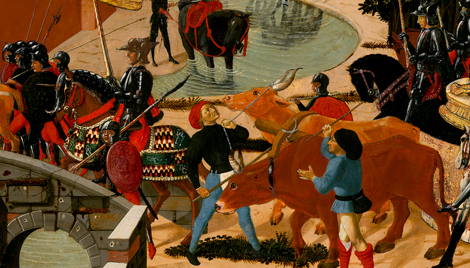Variations at the Cleveland Museum of Art
Danaë, c. 1623. Orazio Gentileschi (Italian, 1563–1639). Oil on canvas; 162 x 228.5 cm. The Cleveland Museum of Art, Leonard C. Hanna Jr. Fund, 1971.101.
This Spring, the Samuel H. Kress Foundation provided support for the public programs associated with an exhibition at the Cleveland Museum of Art, Variations: The Reuse of Models in Paintings by Orazio and Artemisia Gentileschi. The exhibition focused on Italian artist Orazio Gentileschi (1563-1639) and his daughter, Artemisia (1593-1654 or later), and their use and reuse of models and compositions throughout their artistic careers. Centering on three case studies, this exhibition seeks to highlight the skill and innovation employed by father and daughter.
Orazio worked throughout Europe during the 16th and 17th centuries and was heavily influenced by Caravaggio’s dramatic use of lighting and models. A prime example of this is Orazio’s Danaë (c. 1623), which is used as a focal point in the exhibition. The Cleveland Museum of Art’s Danaë was thought to be the premier work on this subject by Orazio when it joined the collection in 1971. The painting is now considered to be a copy done by Orazio from around the same time, after the true original Danaë was found in an English private collection in the 1970s. The original painting was eventually purchased by the J. Paul Getty Museum and remains in that collection.
Danaë and the Shower of Gold, 1621–23. Orazio Gentileschi. Oil on canvas; 161.5 x 227.1 cm. J. Paul Getty Museum, 2016.6.
Copies were a vital part of Orazio’s repertoire and were often considered just as valuable as the original, based on the amount of attention and detail given to each one. The reclining nude figure of Danaë for example is a direct copy of the reclining figure of Mary Magdalene in Orazio’s Penitent Magdalene (c. 1620s), which also has multiple copies. Through the use of tracings, Orazio was able to create these formulaic compositions. When both paintings are overlaid on top of one another, the similarities are even more striking.
Overlay of Danaë from the Cleveland Museum of Art and Penitent Magdalene from the Kunsthistorisches Museum, Vienna.
Artemisia took a similar approach to tracings and formulas as her father, although she eventually developed her own unique style which differs in how body and fabric are depicted. Her Danaë figure (c. 1612) is almost an exact copy of the body used in Death of Cleopatra (c. 1610-12), attributed to either her or her father.
Overlay of Danaë (Saint Louis Museum Art Museum) and Death of Cleopatra (Private Collection) by Artemisia Gentileschi.
The exhibition features one last point of comparison using the two paintings, Young Woman with a Violin (Saint Cecilia) (c. 1612) and Judith and her Maidservant with the Head of Holofernes (c. 1610-12), both by Orazio. Although drastically different subjects, the two paintings lend themselves to the same composition.
Overlay of Young Woman with a Violin (Saint Cecilia) (Detroit Institute of Arts) and Judith and Her Maidservant with the Head of Holofernes (Wadsworth Atheneum Museum of Art) by Orazio Gentileschi.
Each of these three case studies, as well as the rest of their interconnected oeuvre, illustrate Orazio’s and Artemisia’s skill in replicating while still maintaining a high level of quality and detail. For more information regarding these case studies, please visit the exhibition website.



